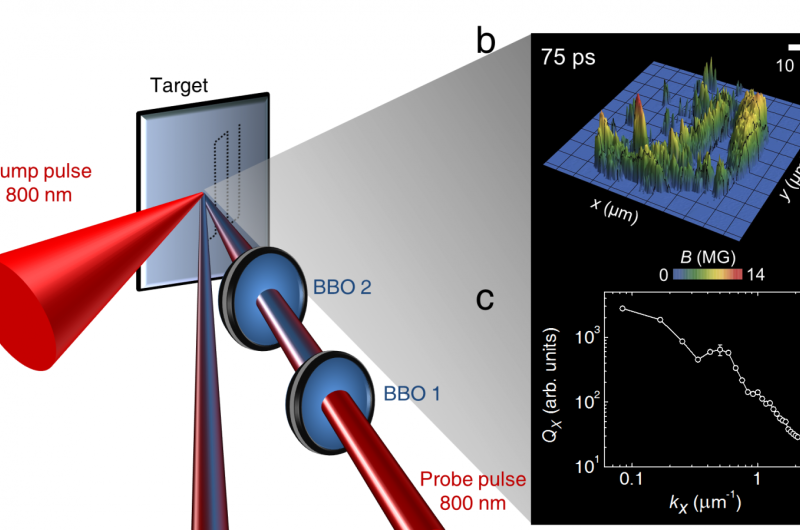Table top plasma gets wind of solar turbulence

Scientists from India and Portugal recreated solar turbulence on a tabletop using a high intensity ultrashort laser pulse to excite a hot, dense plasma and followed the evolution of the giant magnetic field generated by the plasma dynamics. This opens the possibility of studying astrophysical phenomena like the evolution of stars, in the lab.
Turbulent magnetic field dynamics that explain astrophysical phenomena like the evolution of stars have thus far been obtained only through observations via telescopes and satellites. Now, a team of scientists from India and Portugal have recreated such magnetic turbulence on a tabletop in the lab, using a high intensity ultrashort laser pulse to excite a hot, dense plasma on a solid surface and followed the extremely fast evolution of the giant magnetic field generated by the plasma dynamics. This groundbreaking study will be published in Nature Communications on 30 June.
Turbulence is everywhere—from tea cups to tokamaks and from water jets to weather systems, it is something we all see and experience. Yet, even after centuries of serious scientific study, fluid turbulence is still not properly understood. While it is difficult to define turbulence simply, it has many recognizable features, the most common being the fluctuations in parameters like velocity and pressure, indicating randomization of the flow.
Turbulence is not all bad and destructive, despite phenomena like air turbulence on a flight during bad weather. One good feature is that it enables much faster mixing than possible with only normal, slow diffusion. For instance, the sugar added to a cup of tea would take hours or days to disperse undisturbed, but stirring makes the tea turbulent, resulting in fast mixing at the molecular level. Turbulence also helps in mixing fuel and oxygen for efficient combustion in engines.
Much of our universe consists of highly ionized gas known as plasma, which can often be extremely hot and swirling at unimaginable speeds. Turbulence in a plasma is much more complex than that in neutral hydrodynamic fluids. In a charged plasma environment, the negatively charged, light electrons and positive heavy ions respond at vastly different length and time scales. The motion of these charged species is governed by electromagnetic forces and the current flow through the charge particle dynamics leads to magnetic field generation. Therefore, the randomness of magnetic fields often mimics the fluid turbulence in plasmas.
The team of scientists leading this new study find that the turbulence in the magnetic field is initially driven by the electrons (at a trillionth of a second) and the ions step in and take over at longer times. This is the first time such a 'relay race' involving two different species has been glimpsed. Further, these lab observations have an uncanny resemblance to the satellite data on the magnetic field spectra measured for turbulent astrophysical plasmas in the solar wind, solar photosphere and Earth's magnetosheath. Although in the laser experiment the electrons in the plasma are initially energised, the ion dominant response that kicks in at later times shows spectral features similar to those in the astro systems. These experiments thus establish clear connections between the two scenarios, even though the driver of turbulence in the lab plasma is very different from that in the astrophysical system.
More information: Nature Communications (2017). DOI: 10.1038/NCOMMS15970
Journal information: Nature Communications
Provided by Tata Institute of Fundamental Research




















